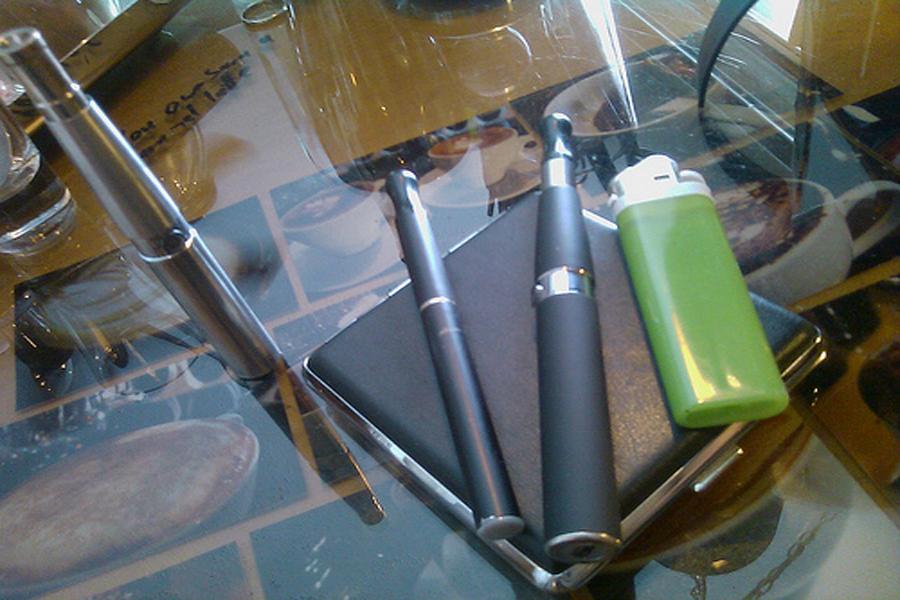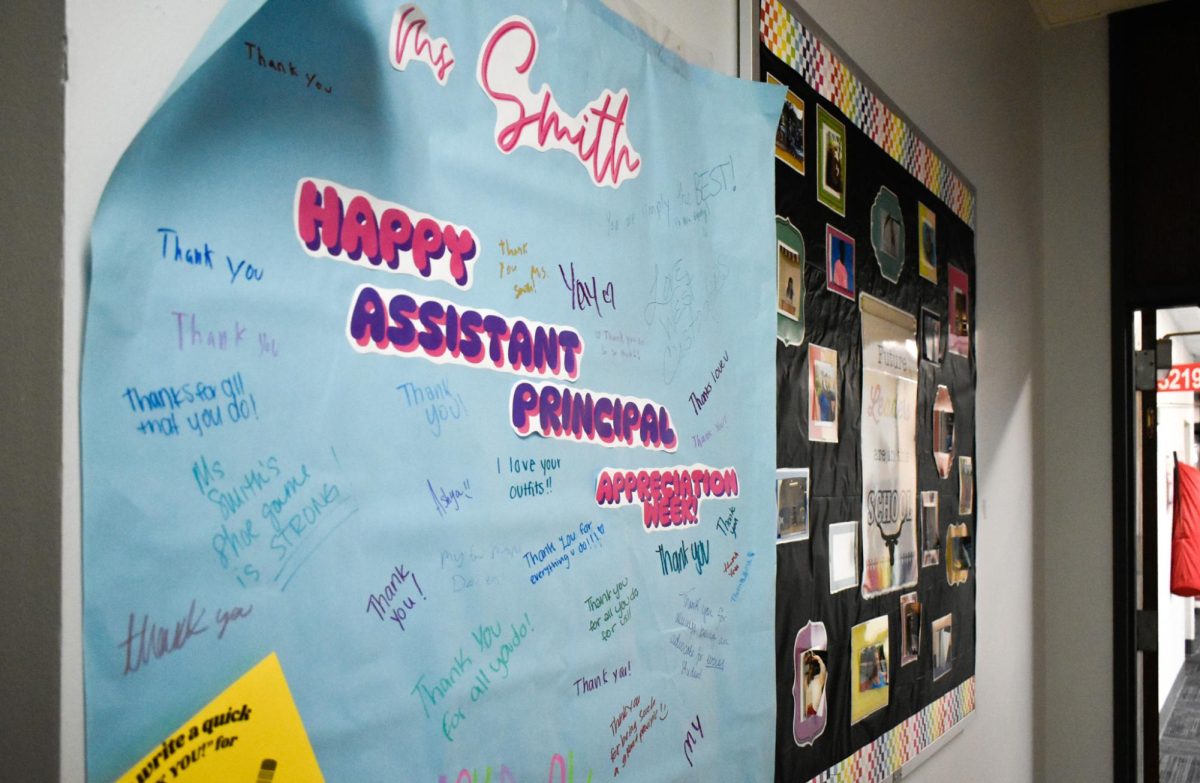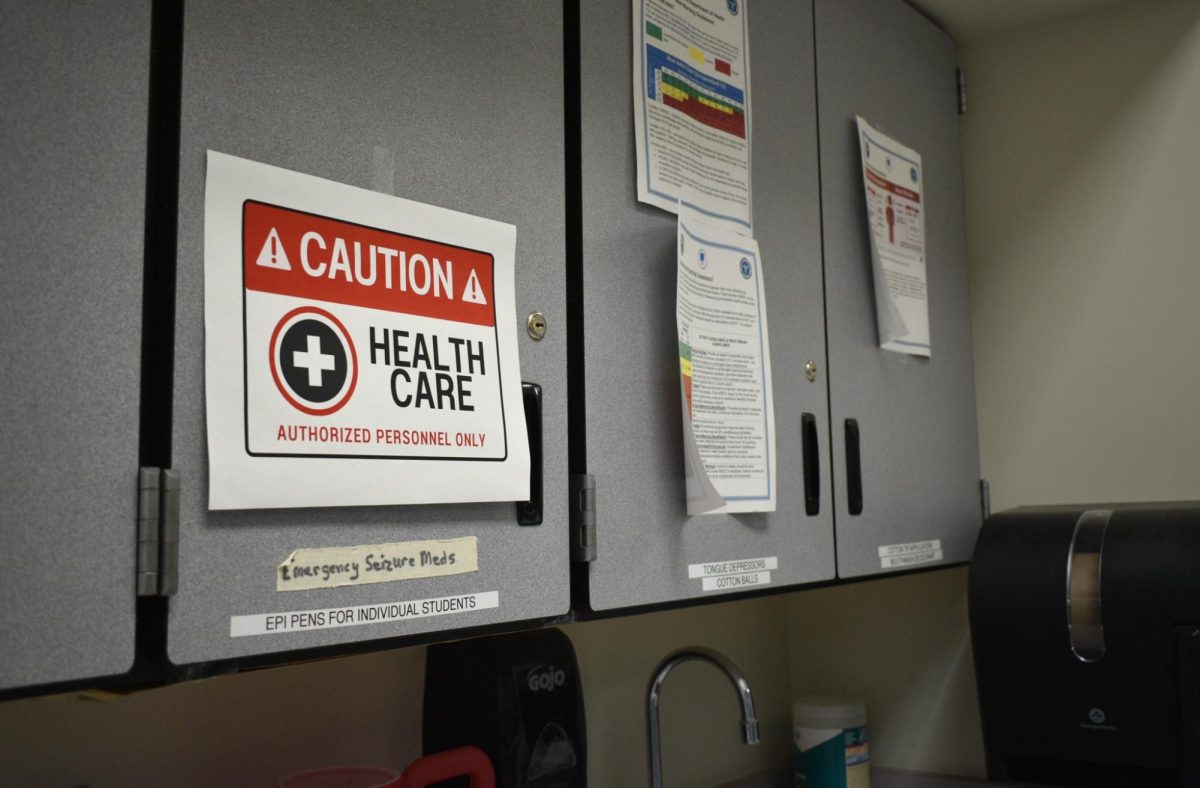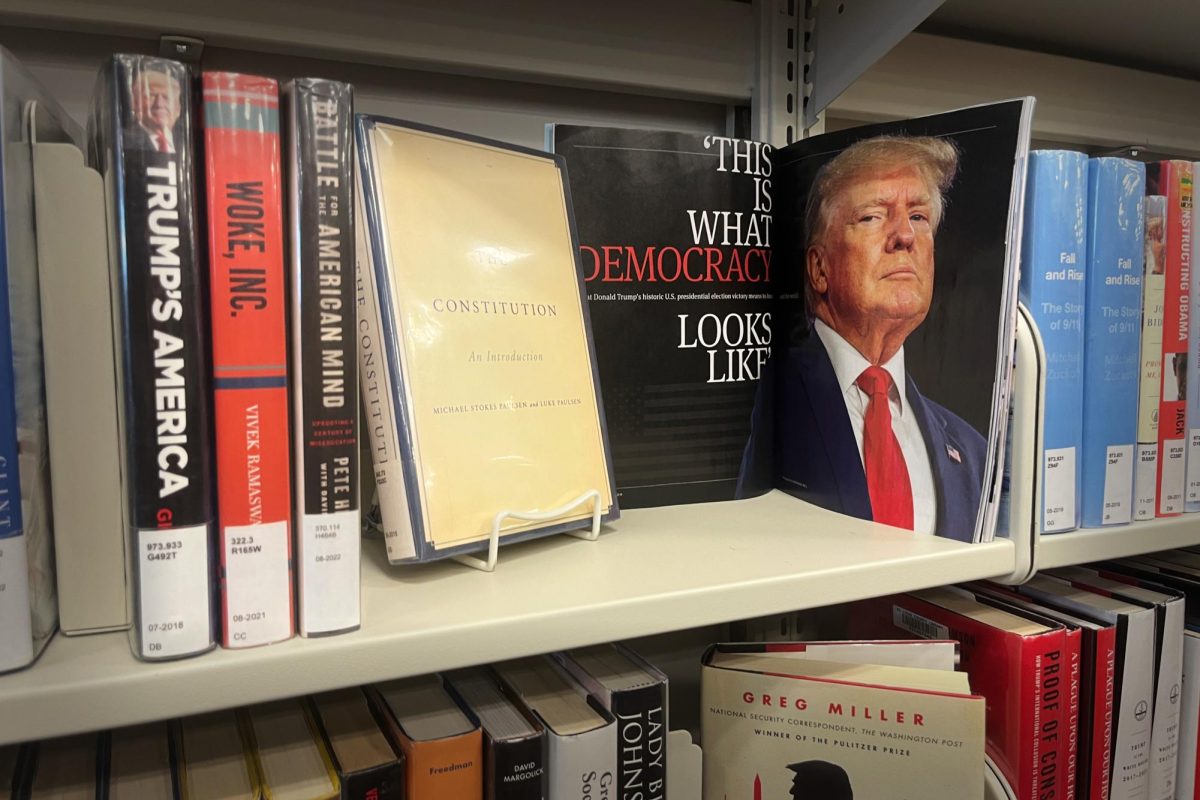Most high school students are not avid smokers; it’s become rare to find a full ashtray in a student’s car and to see tobacco-stained fingertips in the hallways. However, glass pens that emit delicious flavors and pleasant smelling value clouds are rising where students gather. A new form of smoking is on the rise: the e-cigarette.
An e-cigarette is a battery-operated device that uses flavored liquid and heats it to deliver nicotine-laced steam to the user instead of tobacco smoke. Manufacturers market their products as being a safe alternative to traditional means of smoking because it creates vapor instead of smoke, and increase their appeal by adding a range of flavored cartridges like mint, chocolate, and vanilla and designing the e-cigarette to look more like a glass or fountain pen instead of a traditional cigarette. The usage of the e-cigarette, also known as an e-cig, vape, or hookah pen, has escalated from 4.7 percent to 10 percent from 2011 to 2012 according to the Centers for Disease Control and Prevention, and shows no signs of slowing.
E-cigarettes offer the ability to smokers as an alternative way to get their nicotine fix while cutting down on some — not all — of the harmful chemical additives in other tobacco products, allowing them to smoke more discreetly outdoors, and even allowing them to smoke indoors where smoking is usually banned.
Between the attractive flavors and designs and manipulative advertising by e-cigarette manufacturers, it’s no wonder why popularity among students has taken off. The new invention’s popularity and its lack of the usual stigmas attached to smoking have led to smoking on campus slowly becoming more popular. Parkway administrators are faced with a new challenge: should e-cigarettes be banned from campuses, even though they are technically not tobacco products?
Even though e-cigarettes don’t offer the traditional offenses of cigarettes like the strong and damaging smoke and an alarming amount of carcinogens, the answer should still be no. Banning e-cigarettes is essential to continue promoting healthy lifestyles focused on academic and personal success, and to crack down on an already covert-yet-prevalent rate of drug use on campus.
“The amount of smoking on campus is something that warrants our continued attention. We do have people who need to smoke so bad that they try to leave campus to smoke. Kids risking the consequences of smoking is part of the problem,” assistant principal Terry Martinez said.
The nicotine in e-cigarettes builds a dependency on the chemical instead of serving as a device to help quit smoking, as so many in the e-cigarette industry promote. Instead of releasing controlled, small amounts of nicotine to decrease dependency like the patch or nicotine gum, the heat produced in the e-cigarette causes an increased amount of the chemical to be spread into the body. They force nicotine quickly to the lungs, heart and brain, which is what causes addiction in the first place. In this case, less dangerous doesn’t mean completely safe.
Allowing students to smoke e-cigarettes on campus is giving them a free pass to use a gateway to other nicotine products. Health classes drive the harmful effects of nicotine addiction into students from day one: higher risks of cancer, birth defects, and developmental disorders. It would not only be hypocritical of Parkway to allow nicotine consumption on campus while teaching students to respect their bodies and to eschew harmful poisons, but irresponsible because they would be turning a blind eye to a product that is damaging to students’ health while claiming to be keeping teens safe while on campus.
The attractive smells and tastes of e-cigarette flavors poses a distraction within the classroom as well. The false information disseminated among the student population heightens curiosity; after all, if it’s supposed to be safe and tastes pretty good, why not smoke it? Many e-cigarette smokers don’t limit their vaping to lunch. The tips of e-cigarettes can be seen poking out of some students’ sleeves and backpacks during class time, the smell of the flavors can be detected during passing periods, and vapor clouds have been spotted inside of at least one classroom.
“I saw a student smoking out of his sleeve in the middle of a class. It was really discrete and I only knew for sure after he admitted he was,” junior Alya Bajwa said. “I feel like it’s indicative of a bigger problem. If you can get away with smoking in class, what else can you get away with?”
Creating capable, curious, and confident students is Parkway’s educational mission, and having students vape while teachers try to fulfill that mission goes against everything the district wants to project and create. That student is more focused on taking puffs off of their e-cigarette than on their assignment, and is way more disruptive to others than other distractions like a cell phone. When a cloud of vapor suddenly hits my face I’m definitely going to be more distracted by it than someone holding their phone under the desk. Passing the pen around class for other students to use is also disrespectful to the teacher because it shows a preoccupation with being social and fitting in with what’s going on instead of being attentive.
Due to public and media pressures, people who smoke old-school cigarettes at least ask before lighting up in a crowded place. People who use e-cigarettes just go on and vape wherever they are because they’re seen as less offensive, and this behavior is already filtering into West. Banning e-cigarettes entirely would greatly decrease the chance of the devices popping up in classrooms, even if they would theoretically only be allowed outside of class.
Distractions become more serious when an e-cigarette is manipulated to hold butane-extracted hash oil (BHO) instead of the original nicotine liquid. Hash oil is a thick liquid that contains a higher amount of THC, the chemical responsible for creating the high, than other conventional forms of marijuana, creating a stronger and longer high. Smoking hash oil in an e-cigarette gets a person high in a really short amount of time, it doesn’t draw as much attention was holding a joint or pipe, and the smell is virtually non-existent, making it the perfect way to quietly get stoned at school.
“With the legalization of marijuana in Colorado, the next big business is going to be manufacturing a cartridge for marijuana and other substances,” Martinez said. “The drug industry is changing so quickly, and we as a district have to prepare for those changes as best as we can.”
The potential of e-cigarettes to be easily manipulated into holding illegal substances is what should force Parkway’s hand. In an environment where drug dogs, locker searches, and car searches are part of routine, allowing e-cigarettes on campus is irresponsible and negligent of student well being. While there are certainly students who use drugs outside of school, or even leave school and come back stoned, teens lighting up in the hallway or even the classroom is something that’s unacceptable for an educational setting that also promotes a drug-free lifestyle. The presence of e-cigarettes would only make it harder for teachers and administrators to regulate the environment students are involved in while under their care.
A crackdown on e-cigarettes on campus is essential for Parkway to stick to its mission of educating students in the best and safest environment possible. The district’s drug policy states that a student cannot “possess, use, transfer, distribute, or be under the influence of any alcoholic beverage, controlled substance, or imitation controlled substance,” yet, an e-cigarette doesn’t fall neatly into any of those categories. It isn’t an imitation cigarette; it’s something else entirely. The policy also states that chemical substances are considered controlled substances, but is the liquid cartridge of the e-cigarette enough to ban the entire device? These are the questions Parkway has to consider while weighing the risks the new invention poses for students.
Drinking and smoking have had no place on school grounds for years. It’s time to add vaping to that list.
Disclaimer: The views and opinions expressed in this article are those of the authors and do not necessarily reflect the official position of the Parkway School District.


![Leaning on the podium, superintendent Melissa Schneider speaks to Parkway journalism students during a press conference. Schneider joined Parkway in July after working in the Thompson School District in Colorado. “My plan [to bond with students] is to get things on my calendar as much as possible. For example, being in [classes] is very special to me. I am trying to be opportunistic [meeting] kids [and] being in [the school] buildings. I have all the sports schedules and the fine arts schedules on my calendar, so that when I'm available, I can get to them,” Schneider said.](https://pwestpathfinder.com/wp-content/uploads/2025/09/IMG_5425-1200x943.jpeg)


![Red, white and blue, the American flag holds the values of our democracy. The fight that we once endured has returned, as student journalists and senior correspondents across the country are losing their voices due to government control. “[Are] the White House and [the] government limiting free speech [and] freedom of the press? Yes [they are],” chief communications officer of the Parkway School District and former journalist Elisa Tomich said.](https://pwestpathfinder.com/wp-content/uploads/2025/03/Untitled-design-14.jpg)
![A board in the Parkway West counseling department displays pennants of selective universities. With a wide range of students interested in attending, it’s important that these schools have clear priorities when deciding who to admit. “[Washington University] had the major that I wanted, psychology, philosophy, neuroscience. That's a holistic study of the brain, and [WashU is] the only college in the world that offers that. That's the main reason I wanted to go; I got into that program,” senior Dima Layth said.](https://pwestpathfinder.com/wp-content/uploads/2025/02/Flag-1.png)

![Within the U.S., the busiest shopping period of the year is Cyber Week, the time from Thanksgiving through Black Friday and Cyber Monday. This year, shoppers spent $13.3 billion on Cyber Monday, which is a 7.3% year-over-year increase from 2023. “When I was younger, I would always be out with my mom getting Christmas gifts or just shopping in general. Now, as she has gotten older, I've noticed [that almost] every day, I'll open the front door and there's three packages that my mom has ordered. Part of that is she just doesn't always have the time to go to a store for 30 minutes to an hour, but the other part is when she gets bored, she has easy access to [shopping],” junior Grace Garetson said.](https://pwestpathfinder.com/wp-content/uploads/2024/12/DSC_0249.JPG-1200x801.jpg)

![Senior Sally Peters stands in the history hallway, contemplating her choices in the 2024 United States and Missouri elections on Nov. 5. As a member of Diplomacy Club, Peters has discussed key candidates and issues in contemporary American politics. “[As students], we're starting to become adults. We're realizing how much the policies that are enforced and the laws that make it through the House and Senate are starting to affect us. [Opportunities such as] AP [U.S.Government] and Diplomacy Club [make elections feel] a lot more real,” Diplomacy Club vice president and senior Nidhisha Pejathaya said.](https://pwestpathfinder.com/wp-content/uploads/2024/10/Flag-1-1.png)
![Mounting school pressure can leave many students overworked and overstressed. Schools must give students the necessary resources to help assuage student mental health issues and prevent the development of serious crises. “The biggest thing [schools] can do [to protect student mental health] is offer more time [to do work], like a study hall, or offer more support from teachers so that students don't feel stressed out and can get help in areas that they need,” senior Bhavya Gupta said.](https://pwestpathfinder.com/wp-content/uploads/2024/09/unnamed-4.jpg)
![After a thrilling point, senior Katie Byergo and junior Elle Lanferseick high-five each other on Oct. 8. With teamwork and camaraderie, Byergo worked together in the game against Lafayette High School. “[Byergo’s] is really positive with a good spirit,” Lanferseick said. “I set her [the ball] and she hits it [or] gets the kill.”](https://pwestpathfinder.com/wp-content/uploads/2025/10/DSC_9349-1-e1761159125735-1200x791.jpg)
![Focused on providing exceptional service, sophomore Darsh Mahapatra carefully cleans the door of a customer’s car. Mahapatra has always believed his customers deserve nothing less than the best. “[If] they’re trusting us with their car and our service, then I am convinced that they deserve our 100 percent effort and beyond,” Mahapatra said.](https://pwestpathfinder.com/wp-content/uploads/2025/10/DSC_0018-1200x800.jpg)
![Sophomore Aleix Pi de Cabanyes Navarro (left) finishes up a soccer game while junior Ava Muench (right) warms up for cross country practice. The two came to Parkway West High School as exchange students for the 2025-2026 school year. “The goal for the [exchange] program is to provide opportunities for both Parkway students and our international exchange students to learn about other cultures, build connections and become confident, capable, curious and caring — Parkway’s Four C’s — in the process,” Exchange Program Lead Lauren Farrelly said.](https://pwestpathfinder.com/wp-content/uploads/2025/10/Feature-Photo-1200x800.png)
![Gazing across the stage, sophomore Alexis Monteleone performs in the school theater. The Monteleone family’s band “Monte and the Machine” has been releasing music since 2012, but Alexis started her own solo career in 2024 with the release of her first single, Crying Skies. “My whole family is very musical, [and I especially] love writing [songs with them],” Monteleone said.](https://pwestpathfinder.com/wp-content/uploads/2025/09/DSC7463-1200x798.jpg)

![Leaping through the air, senior Tyler Watts celebrates his first goal of the season, which put the Longhorns up 1-0 against the Lafayette Lancers. Watts decided to play soccer for West for his last year of high school and secured a spot on the varsity roster. “[Playing soccer for West] is something I had always dreamed of, but hadn’t really had a good opportunity to do until now. It’s [really] fun being out [on the field], and I’m glad I decided to join the team. It’s just all about having fun with the boys and enjoying what time we have left together,” Watts said.](https://pwestpathfinder.com/wp-content/uploads/2025/09/DSC_1951-1200x855.jpg)
![Shifting global trade, President Donald Trump’s tariffs are raising concerns about economic stability for the U.S. and other countries alike. “[The tariffs are] going to pose a distinct challenge to the U.S. economy and a challenge to the global economy on the whole because it's going to greatly upset who trades with who and where resources and products are going to come from,” social studies teacher Melvin Trotier said.](https://pwestpathfinder.com/wp-content/uploads/2025/05/MDB_3456-1200x800.jpg)

![Pitching the ball on Apr. 14, senior Henry Wild and his team play against Belleville East. Wild was named scholar athlete of the year by St. Louis Post-Dispatch after maintaining a high cumulative GPA and staying involved with athletics for all of high school. “It’s an amazing honor. I feel very blessed to have the opportunity to represent my school [and] what [it] stands for,” Wild said.](https://pwestpathfinder.com/wp-content/uploads/2025/05/unnamed-6-1200x714.jpg)
![Freezing in their position, the Addams Family cast hits the “rigor mortis” pose after cast member and senior Jack Mullen, in character as Gomez Addams, calls out the stiff death move. For the past four months, the combined company of cast members, orchestra pit, crew and directors all worked to create the familial chemistry of the show. “I’m excited for [the audience] to see the numbers, the music, the scenes, but I also just love all the technical aspects of it. The whole spectacle, the costumes, makeup and the people that put in the work backstage in order to make the show successful on stage. I’m excited for people to see and appreciate that,” Mullen said.](https://pwestpathfinder.com/wp-content/uploads/2025/03/DSC0116-1200x800.jpg)